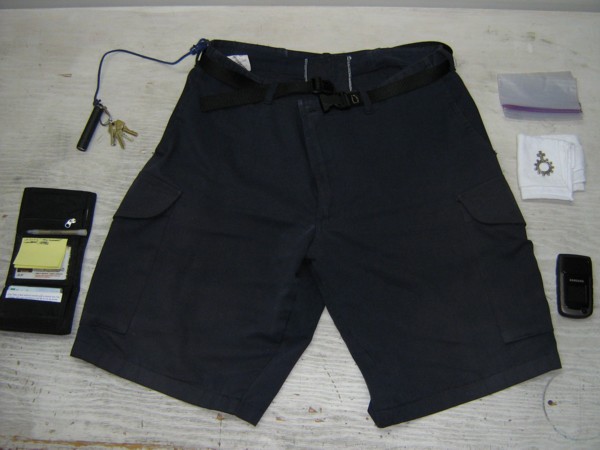
Overview of the EDC.
Let's Adore Jesus-Eucharist! | Home >> Varia >> Bachelor's Kit

Overview of the EDC.
1) Introduction
esd1) Finger rosary
esd2) Pants
esd3) "Combat slippers" (clean hiking shoes)
esd4) Keychain
esd5) Wallet
esd6) Headlamp
esd7) Knife
esd8) Watch
t6) Ballpoint pen
t7) Small disposable lighter
t9) Rechargeable hankerchief
t10) Pants
t11) Belt
t12) Ziploc bag
2) Other personal necessities
3) Appendix: Other options to carry the EDC
The EDC, or Every Day Carry, is the minimum of equipment that one must always carry. In French, I call it "Adam's Pants", because we always wear our "Adam's (or Eve's) Uniform". (See below for other options to carry the EDC.)
Because I just about always wear my underwear and shoes, I also include them in my EDC. (My pyjamas are also my underwear. Moreover, my "slippers" are always on my feet or next to my bed, and my "slippers" are in fact identical twins of my hiking shoes, but that I never wear outside the house, except in an emergency.) This is why I took the liberty of extending the customary notion of EDC to include everything I actually pretty much always have with me.

Description: The "Scout's Rosary". It's just a small handy ring, with a Crucifix and ten "bumps" to count decades of Ave Marias for the Holy Rosary. (Which can include the Prepareful Mysteries!)
Conception: Don't underestimate the importance of having a physical object on yourself which reminds you of your duties as a Soldier of Christ. And even from a strictly material point of view, Napoleon often repeated that: "The moral is to the physical as three is to one".
Price: 2$
Errors: Normal Rosary get's constantly tangled up. Finger Rosary connected to keychain quickly breaks. Put by itself in another pocket, it never breaks.
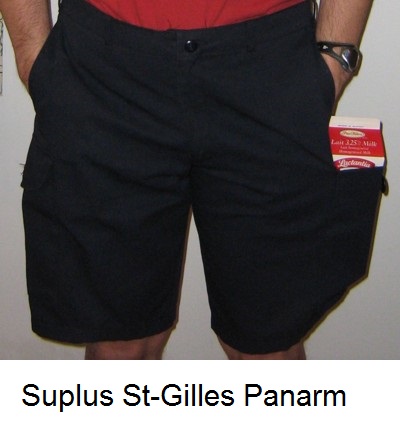
Description: Work pants, with large cargo pockets on thighs, polyester/cotton fabric, long or short according to season, color that doesn't show dirt and that doesn't draw attention in public.
Design: I really love big cargo pockets on the thighs (yes, it's a 2 liter container you can see in that pocket)!
Includes: The pants, on top of containing every other object in this list (except for the underwear and shoes), also include:
- belt.
- Plastic bag: Ordinary plastic bag with "ziploc" closure, large enough to contain the whole EDC. It's kept folded in back pocket. Comes in handy when you get stuck in the rain. Also nice when we need to temporarily empty all of our pockets and we don't want to lose anything (like when passing security at the airport, etc.). I should run tests to see how long they remain waterproof (such bags wear out quickly because folded and sat on daily).
Use: The least bad kind of pants I've been able to find so far requires many modifications after purchase: remove the front pocket flaps and their associated buttons (I find these flaps prevent hands from being inserted quickly into the pockets), removing the little ankle cords (useless), replace the very low quality zipper with something more robust, and sewing right away patches for the pant seat. And since I often wear shorts, and that the current model doesn't exist in "short pants", I must also often cut the legs and redo the hems.

Patch for pant seat.
The first thing that wears out on my pants is inevitably the crotch area between the legs. I easily double the life of a pair of my pants by sewing patches. I start by unstitching the two big seams in the seat of the pants, then I sew two fairly large patches to cover the worn fabric (see pattern in white paper in the picture here above), then I sew back the two main seams. The patches themselves are sewn with thread the same color as the rest of the pants, in order to merge as fully as possible the two layers (the patch, and the original worn layer of fabric). The white thread you can see on the picture is just the overlock inside.
Price: 45$
Errors: About any pair of pants sold by www.mec.ca: fabric too fragile, pockets too numerous and small, colors too garish.
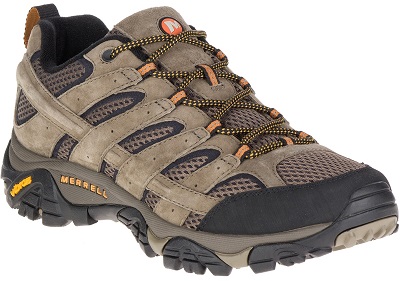
Description: Hiking shoes.
Design: They must be: (i) comfortable (if you're no longer able to move after a few kilometers because of blisters, the shoe is bad!); (ii) with a non-slip sole (if you break your bones because of a fall, the shoe is also bad!); (iii) light (the saying "one kilo on the feet equals six kilos in the backpack" is explained by the need to overcome the inertia of the shoe's mass, in the continual reciprocating movement of the feet. Compromises to minimize weight are often pay well.); (iv) well ventilated, so the foot breathes (no Gore-Tex, for example).
TODO translate: Une autre bonne raison pour avoir des «pantoufles» identiques à vos souliers de marche est pour diminuer la douleur des fascites plantaires (il n'est pas recommandé de marcher pieds nus ou en chaussettes seules dans la maison).
Includes:
- laces.
- insoles. They lose their elasticity. Should I separately buy insoles of better quality, and change them more often?
Use:
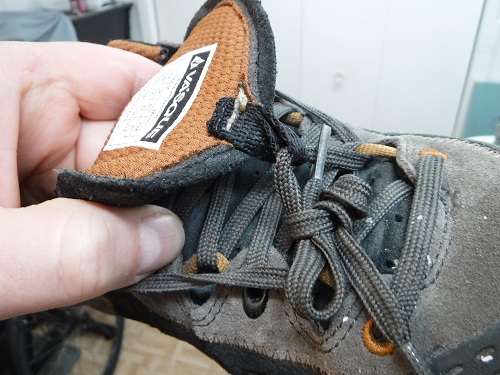
Loop to roll up tongue.
"Slipper" mode. I really like having slippers that I can put on quickly and easily, but that can be used as tightly-laced regular shoes in case of emergency. Just sew a small loop on the tongue, in which you pass the laces to roll it up. With a bit of practice, you learn to tighten the laces just enough so the "slipper" doesn't fall off, while still being lose enough so you can slip it on without bending over.
Price: 140$
Errors: Errors: I've committed several:
- Lacing area too short. Lacing that did not go low enough down toward the toes, so the shoe did not hold firmly to the foot.
- Slippers. I've owned real slippers before, but I had to think about removing my slippers and putting on real shoes in an emergency. In an emergency, every second counts, and when you wake up suddenly, even simple operations take time. So all the time and effort putting on slippers was wasted. In addition, trying to go outside with slippers in the Wintertime leads to falls that quickly convince us of the foolishness of such an approach! A brand new shoe is clean, why not use it as a slipper? And what's more, when our real shoes are worn out, we already have identical shoes, almost unused, ready to fill the vacant position.
- Sandals. The idea seemed good for Summers, but a sandal will always be difficult to put on like a slipper, or it will not "hold" the foot well enough. In addition, by definition, a sandal allows small rocks to lodge themselves under the foot (and branches or wires to get caught between toes and the sandal, leading to a beautiful face plant of the wearer of the aforementioned sandals!). A good, well ventilated walking shoe, worn in slipper mode, is almost as "ventilated" as a sandal, but much more practical when an emergency occurs. Yes, there are "sandals" that look a lot like shoes, but it's more of a proof that the shoe is the right solution.
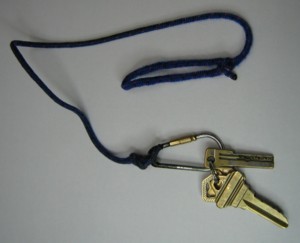
Description: Important keys, attached together and to oneself.
Includes: Keys, small carabiner with screwed gate (MEC Mini Versa Link), cord to attach to pants, flashlight.
Use: As far as possible, I remove the "large handles" of certain keys (far to big and heavy for nothing). Oil screw gate annually.
Price: 4$
Errors: Fragile key ring: I've tried all kinds of rings to hold the keys. If the ring doesn't open, it's simple and strong. On the other hand, it becomes difficult to disconnect the car key, or to add other keys, or to remove the keychain flashlight, etc. But if the ring can be opened, after many open-close cycles it eventually breaks and we loose all our keys! The least bad solution I've found is a ring with a screwed gate, and I screw it tightly closed, every time. I've never again had problems with broken rings, with the disadvantage of an additional effort every time I open and close the screwed gate.
Forgotten keychain: since I've started to attach my keychain to my pants, I've never again forgotten my keys. Thank God, I haven't yet gone out of the house without my pants!
The precious object catapult: a big disadvantage of attaching the keychain to our pants is the keychain has a tendancy to catapult out other objects that have had the misfortune of being placed in the same pocket, when we pull on the string to get the keys out. I had to lay down a strict law: nothing in the keychain pocket, unless it's screwed on to the ring (after having catapulted my non-screwed car keys into a snowbank, at night, while pulling on the cord to go get my house key).

Description: Nylon wallet, tri-fold, velcro closure, with small zippered compartment, a few slots for cards, etc.
Includes:
- important cards (credit card, driver's license, ATM card, 2-3 business cards,
that's all);
- emergency cash (in one of the hidden compartments);
- the most important addresses and telephone numbers (for example, everything
you can pile onto the equivalent of one business card) in case of total loss
of computer;
- a few scraps of paper to take notes and leave messages (like yellow "Post-Its");
- ballpoint pen;
- backup copies;
- small disposable butane lighter (I wrap a bit of electrician's tape on the
button to avoid leaks. Stored in the wallet's little zippered compartment,
along with the backup copies.);
- First Aid Cheat Sheet
(credit card sized).
Price: 35$
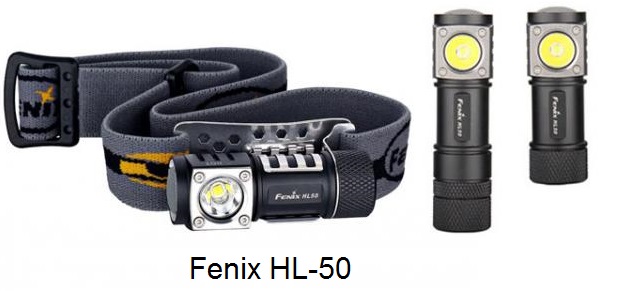
Headlamp.
Description: Small aluminum flashlight, that can be worn on the forehead (to free up both hands) but as far as possible that can be disconnected from the head harness to reduce bulk, waterproof, LED of at least 100 lumens, one single AA cell, if possible rotary switch.
Design:
Headlamp or handheld? The headlamp has every advantage, except for bulk and weight (you need a harness to hold it up on the forehead, and a mechanism to orient the beam either close to you, like when you're reading, or far away, like when you're bicycling). Since you almost inevitably need both hands when you need light, headlamps have an insurmountable advantage. If on top of that you can detach the headlamp from its harness, then in theory you can have the best of both worlds.
What format of and number of cells? According to me, AA format cells offer the best combination of duration of lighting, compactness, availability in stores, and affordability. Moreover, with modern LEDs, a single cell is plenty enough for my needs, which allows a flashlight of (relatively) small size, which fits in a pocket and in the mouth (to free up your hands when you don't have the head harness).
What kind of cell chemistry? Lithium non-rechargeable. Rechargeable cells discharge by themselves with time, which is inacceptable. Non rechargeable alkalines are heavier, lose voltage at low temperature (outside in the Winter), and don't last as long as non-rechargeable lithiums.
Rotary or push-button switch? A rotary switch is the simplest, the most waterproof, the easiest to maintain, and on top of that it doubles as an access hatch to change the batteries. Push-button switches will always be more fragile (of all the flashlights I've owned, the most common failure has been a broken switch, after batteries leaking), but also more handy, so they are appropriate for a less-essential flashlight (like the toolbox headlamp).
Includes: One AA lithium non-rechargeable battery.
Use: (If you can find high-quality elastics of the right length and width)
Wrap with "head elastic", as loosely as possible without having
the elastic fall off, to prevent it stretching unnecessarily. The elastic
has to be replaced periodically (every 2 years?). I also insert a small piece
of 3x5 card to prevent the cell from rattling inside the flashlight.
The flashlight is normally attached to the keyring.
Lubricate the O-ring with scilion grease regularly (twice a year? depends
on how often you use it). As soon as you need a fresh AA battery elsewhere
in the household, put the new battery in this EDC flashlight, and take
its battery and use it to replace the battery you really wanted to change.
SHTF,
you want your EDC flashlight to be as fresh as possible).
Note for the Fenix HL-50: because the steel clip to hold the flashlight had edges that would dig into my skin in certain conditions when carried in my cargo pocket, I tried just removing it, and attaching the flashlight directly to the big elastic. That mostly removed all the practicality of the clip, but still remained a bit too bulky to carry constantly. So I went back to unclipping the flashlight from the headband, but keeping the headband close.
Quantity: Only one in the EDC pants, but the flashlight is too important to have only one. There are others in the Kit.
Price: 40$
Quelle chimie de pile? Si on peut se les payer, lithium non-rechargeable. Les piles rechargeables se déchargent toutes seules avec le temps, ce qui est inacceptable. Les piles non-rechageables alkaline sont plus lourdes, subissent une baisse de voltage à basse température (dehors en hiver), et durent moins longtemps que les lithium non-rechargeables. En pratique, à cause de leur coût plus élevé, j'en garde quelques-unes dans mon sac d'escampette, mais j'utilise normalement les alkalines.
Commutateur rotatif ou à bouton-pressoir? Le commutateur rotatif est le mécanisme le plus simple, le plus étanche, le plus facile d'entretien, et en plus il sert aussi à ouvrir la torche pour changer la pile. Les boutons-pressoirs seront toujours plus fragiles (de toutes les torches électriques que j'ai eues, la panne la plus fréquente a été les commutateurs brisés, après les piles qui coulent). En pratique, je ne trouve pratiquement plus de torches électriques avec des commutateurs rotatifs, et zéro lampes frontales, donc j'endure les autres.
De quoi aurait l'air la lampe frontale idéale? La Fenix HL-50 s'en approchait (je pense qu'elle est déjà discontinuée). J'aurais changé ceci:
- Remplacer le bouton-pressoir avec un commutateur rotatif purement mécanique.
- Éliminer le mécanisme permettant de fonctionner avec des CR123 (lourd et
compliqué pour rien).
- Ajouter oeilleton métallique intégré au
bouchon métallique pour avoir l'option de l'attacher solidement à soi avec un
cordon.
- Peut-être qu'un réceptacle de harnais plus robuste, des filtres/diffracteurs de
couleur, et un «mode pulsé», auraient permis de s'en servir comme phares de vélo.
Comprend: Une pile AA non-rechargeable (lithium idéalement, alkaline autrement).
Utilisation:
Graisser joint torique au scilicone régulièrement (deux fois par année? ça
dépend de la fréquence d'utilisation). Dès qu'on change une pile AA ailleurs
dans la maisonnée, mettre la pile neuve dans cette torche des Culottes d'Adam,
et prendre celle de la torche pour remplacer la pile qu'on voulait vraiment
remplacer (quand la
MFLV,
on veut une pile la plus neuve possible).
Quantité: Une seule dans les Culottes d'Adam, mais la torche électrique est trop importante pour n'en avoir qu'une. Il y en a d'autres ailleurs dans la Trousse.
Prix: 68$
Erreurs: Doux Jésus, j'ai tellement gaspillé d'argent sur les torches électriques durant toutes ces années! Que d'erreurs! Quelques-unes dont je me souviens:
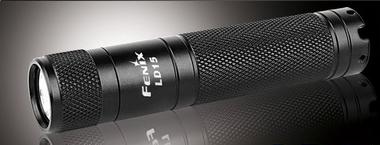
Torche électrique: Fenix Tactical LD15.
Pas vraiment une erreur: Fenix Tactical LD15. En fait, elle était parfaite, sauf qu'elle n'était pas une lampe frontale... J'ai fait toutes sortes de tentatives pour bricoler des élastiques de toutes sortes pour pouvoir la faire tenir sur ma tête, mais sans succès. Je pense qu'une torche électrique de la grandeur d'une pile AA doit avoir sa lentille qui pointe à 90 degrés, et non pas droit devant (pour pouvoir pivoter et pointer dans la bonne direction). Pas moyen de bricoler cela...
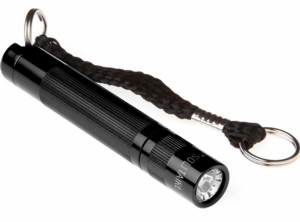
Erreur: Mag-Lite Solitaire.
Mag-Lite Solitaire: ampoule incandescante qui brûle souvent, au pire moment, et qui est très difficile à changer. Pas étanche. Pile AAA. Mauvaise qualité de fabrication.
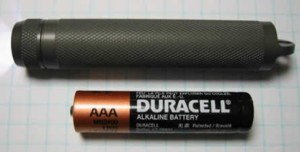
Erreur: Arc-AAA Premium w/GS LED.
Erreur: Arc-AAA Premium w/GS LED: Avantages: deuxième meilleure torche que j'ai eu dans ma vie. Désavantages: Fournisseur bizarre, torche très cher, pile AAA contient beaucoup moins d'électricité que AA, et est moins facile à trouver. Commutateur rotatif défaille sporadiquement et sans explication.

Erreur: Fenix Tactical Headband.
Erreur: Fenix Tactical Headband: Semblait idée géniale: les courroies, le porte-piles et le porte-torche qui peuvent transformer n'importe quelle petite torche électrique en une lampe frontale. Cochonnerie immense et lourde, mal pensée, mal construite. Inutilisable.
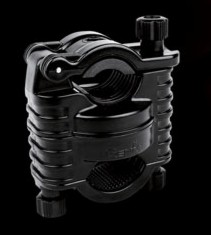
Erreur: Fenix Tactical Bike Flashlight Mount AF02.
Erreur: Fenix Tactical Bike Flashlight Mount AF02: Semblait idée géniale: de quoi transformer n'importe quelle petite torche en lampe de vélo. Cochonnerie immense et lourde (mon Dieu quelle lourdeur! mais quel non-ingénieur a conçu cette foutaise?), mal pensée, mal construite.
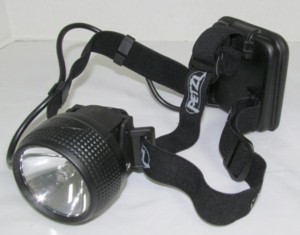
Erreur: Petzl 4.5V halogen headlamp.
Erreur: Petzl 4.5V halogen headlamp: Immense compartiment à pile à l'arrière (il y avait un adapteur pour piles AA, mais cela laissait beaucoup d'espace vide), lampe frontale en générale beaucoup trop grosse, prix très élevé, pas étanche, etc.

Erreur: Garrity LED avec deux piles type monnaie «CR-20».
Erreur: Garrity LED avec deux piles type monnaie «CR-20»: Avantages: éclaire bien (pour une mini-torche), ne prend presque pas de place, facile à ouvrir vite (simple pression sur bouton), ne s'ouvre pas trop facilement toute seule dans la poche, très abordable. Désavantages: pas étanche, piles non-standard (j'essaie de me limiter aux AA, AAA et 9V), très fragile, ahurissante pour changer les piles, pas vraiment possible de la tenir par sa bouche pendant qu'on travaille avec ses mains.
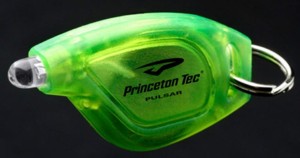
Erreur: Princeton Tech Pulsar II.
Erreur: Princeton Tec Pulsar II: Avantages: minuscule et légère, et fonctionne au DEL. Désavantages: piles non-standard et qui ne durent pas longtemps, pas étanche, mais surtout, s'allume tout seul dans notre poche, sans qu'on s'en aperçoive! Alors le jour où on en a besoin, pouf, les piles sont vides... Un interrupteur rotatif est impossible à allumer par inadvertance.
![]()
Black Diamond Icon.
[Source
de la photo et de l'article qui me l'ont fait acheter]
Black Diamond Icon: Plus ou moins erreur. Si j'avais connu la Fenix HL-50 à ce moment, je ne l'aurais pas acheté. Entre autres, le mécanisme qui fait pivoter la lampe ne pivote pas assez vers le bas, alors on ne peut pas éclairer ce sur quoi on travaille, quand c'est près de nous. Si j'avais seulement le choix entre la Princeton Tech Eos et celle-ci, je choisirais celle-ci.
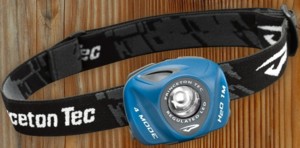
Princeton Tech Eos.
Princeton Tech Eos: Plus ou moins erreur. Si j'avais connu la Fenix HL-50 à ce moment, je ne l'aurais pas acheté. Avantages: petite, légère, orientable haut bas, lampe frontale donc mains libres pour travailler! Désavantages: beaucoup trop grosse et encombrante pour trimballer sur soi constamment. Piles AAA peu denses en énergie. Mécanisme assurant l'étanchéité épeurant (joint bizarre et rare et facile à endommager avec du sable ou autre, vis fragile, etc.). Bouton d'allumage fragile. Mécanisme pour l'orienter en plastique fragile.
I thought I had found a pretty good solution when I discovered "head elastics". Such elastics are easy to find in a logical but weird place: the women's section in a pharmacy, where they keep headbands and other thingies that women put in their hair. You just need to cut off the stuff they put around the elastic to hide the fact it's just a big elastic!
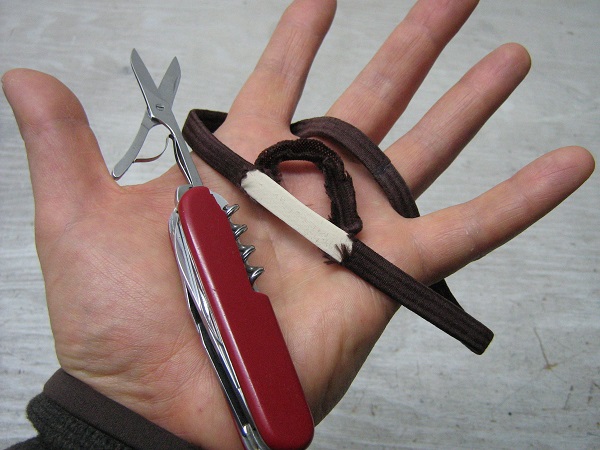
Head elastic.
If I just need a quick light, for example to find a keyhole, I just turn on my flashlight for a few moments, without removing it from the keychain.
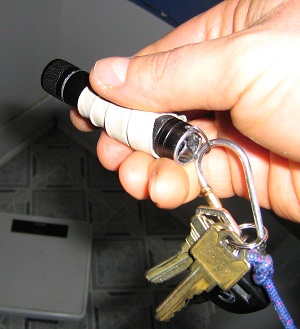
Flashlight attached to keychain.
If I need light a bit longer, I unclip my flashlight from the key chain and stick it in my mouth. This works surprisingly well: (i) the single AA cell flashlight is not heavy or big, so it's easy to hold with your teeth; (ii) the big rubber band wrapped around it prevents your teeth from touching the metal.

Flashlight held in teeth.
If I need to work with both hands in the dark, for a longer period of time, I unwrap the big elastic and put it around my head, and stick the flashlight under it, a bit like when you put a pencil behind your ear. The grippy elastic holds the flashlight quite well (you can shake your head hard and it doesn't move), and you can adjust the angle of the flashlight to point where you are working. It's not a perfect solution: it does take time to unclip the flashlight, unwrap the elastic, put it on your head, and when you wear safety glasses to work, the light tends to hit your glasses and bounce back at you annoyingly.
The big elastic has other advantages. It tends to prevent the keys from banging around (when you go jogging, you can even slip the keys under the elastic to totally keep them quiet). Also, I've never tried it, but maybe such a setup could be used as makeshift bicycle lights, if I could find a red filter for the back light.
But all this ingeniuity falls apart because those elastics break at the worse possible time. They seem to disintegrate very quickly. Was it just that I got a bad batch, or headbands that had been sitting on the pharmacy's shelf for years, while the rubber degraded with the oxygen? Could I get higher-quality elastics? Should I replace the string on my keychain with something elastic, or adjustable (a kind of "barrel-lock") so it could also be used to hold my flashlight on my head?
Anyway, for the time being I wrap a bit of electrical tape at the back of the flashlight, so at least I can bite into it, and the keys don't rattle so much.
In my toolbox, since I necessarily need both hands to work with my tools, I currently have a true headlampe (Fenix HL-50) which gets used almost constantly.

Fenix HL-50.
[Source
photo,
manufacturer's
web site]
Fenix HL-50: best headlamp I've had so far. Small, light, powerful, uses either AA (the easiest battery to obtain) or the CR123 (which contain about 30% more electricity), user-friendly push-button switch (not 36 operating modes which I can't remember how to find), used clipped on headband as headlamp, or clipped off as small flashlight, pivoting mechanism that can be oriented way up (like when you're stuck in a crawlspace and you need to light up above your head), or very low (like when you're reading a book close to yourself).
Improvements? No easy way to connect it solidly to a keychain. I wish they had a special clip adaptor to use it as a bicycle light. I don't know how durable the push-button switch is. I haven't yet dared to unclip it from the headband to put it on my keychain, because the glass protecting the LED seems very vulnerable.
Errors: Gentle Jesus, I've spent so much money on flashlights all those years! So many errors! Here are a few I remember:

Error: Mag-Lite Solitaire.
Error: Mag-Lite Solitaire: incandescant bulb which often burns out at the worst possible moment, and is hard to change. Not waterproof. AAA battery. Poor manufacturing quality.

Error: Arc-AAA Premium w/GS LED.
Error: Arc-AAA Premium w/GS LED: Advantages: second best flashlight I've ever had in my life. Disadvantages: weird vendor, very expensive flashlight, AAA battery contains a lot less energy than an AA, and is harder to find. Rotary switch fails sporadically and without explanation.

Error: Fenix Tactical Headband.
Error: Fenix Tactical Headband: Seemed a brilliant idea: the straps, the battery holder and the flashlight clamp can transform any small flashlight into a headlamp. Huge and heavy piece of crap, poorly thought-out, poorly built. Useless.

Error: Fenix Tactical Bike Flashlight Mount AF02.
Error: Fenix Tactical Bike Flashlight Mount AF02: Seemed a brilliant idea: something to transform any small flashlight into a bicycle lamp. Huge and heavy piece of crap (Lord, the weight! what kind of engineer would design such junk?), poorly thought-out, poorly constructed.

Error: Petzl 4.5V halogen headlamp.
Error: Petzl 4.5V halogen headlamp: Huge battery compartment (there was an adaptor for AA batteries, but that left a lot of unused space inside), headlamp overall was very big, very expensive, not waterproof, etc.

Error: Garrity LED with two coin-type "CR-20" batteries.
Error: Garrity LED with two coin-type "CR-20": Advantages: lights up quite well, (for a mini-flashlight), takes up almost no place, easy to turn on (simple pressure on the button), doesn't open by itself in the pocket, very affordable. Disadvantages: not waterproof, non-standard batteries (I try to stick to AA, AAA and 9V), very fragile, mind-boggling to change batteries, not really possible to hold in mouth to free up hands.

Error: Princeton Tech Pulsar II.
Error: Princeton Tec Pulsar II: Advantages: tiny and lightweight, uses an LED. Disadvantages: non-standard battery, which doesn't last long enough, not waterproof, but especially, turn on all by itself when in your pocket, and you can't see it has turned on! So the day you need it, poof, the batteries are empty... A rotary switch can't turn on inadvertantly.
![]()
Black Diamond Icon.
[Source
of the picture and the review that made me buy it]
Black Diamond Icon: More or less an error. If I had known about the Fenix HL-50 in those days, I would never have purchased it. Among others, the pivoting mechanism doesn't go down enough, so you can't illuminate what you're working on, if it's really close to you. If I only had the choice between the Princeton Tech Eos and this one, I'd chose this one.

Princeton Tech Eos.
Princeton Tech Eos: More or less an error. If I had known about the Fenix HL-50 in those days, I would never have purchased it. Advantages: small, lightweight, can be oriented top to bottom, and it's a headlamp so it frees up the hands to work! Disadvantages: far to cumbersome to carry constantly on oneself. Lower energy density AAA batteries. Waterproofness mechanism of scary fragility (rare and weird joint that is easy to damage with sand or something else, fragile screw, etc.). Fragile on-off button. Fragile plastic orientation mechanism.
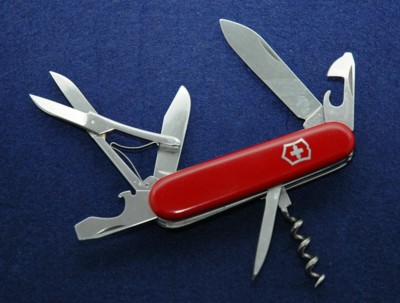
Knife for the city: Victorinox Climber.
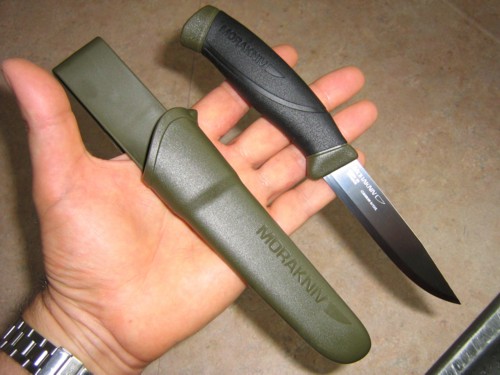
Knife for the great outdoors: Mora Companion MG.
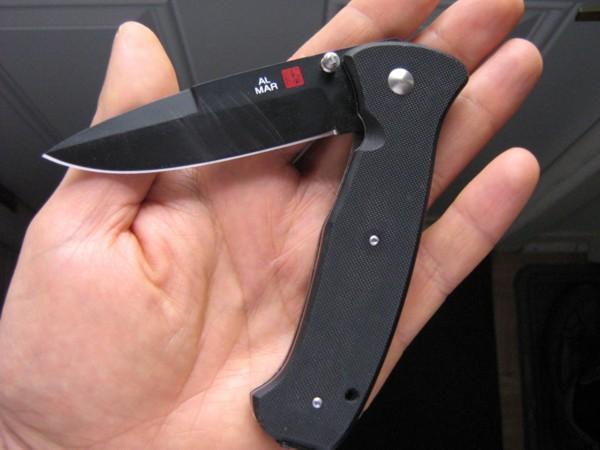
Knife for in between the city and the great outdoors: AlMar SERE 2000.
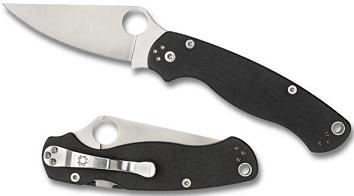
Another option for in between the city and the great outdoors: Spyderco Paramilitary 2.
Design: I'm a bit stumped for the jackknife. What I'd like apparently doesn't exist on the market. Some "dimensions" of the design space:
- The more often you slice, the thinner the blade should be (try cutting
carrots with a thick blade!).
- The more you chop or stab or pry or otherwise impose large non-slicing
forces on the blade, the thicker the blade should be.
- In general, a more brittle steel keeps an edge longer, but breaks easier and
is harder to sharpen.
- The more you want your knife to stay sharp wherever you are, the less
you want blades with hard-to-sharpen shapes (e.g. serrations).
- The more you want to get work done with your knife, the less you want
a knife that sacrifices function in order to be a "fashion statement"
(i.e. strange or threatening blade shapes, expensive metal finishings
that are purely esthetic, etc.).
- The more you are deep in the jungle (or the tundra, or the desert, etc.),
the less you care about hiding your knife, the more you want your knife to be
close at hand, and the less you want a complicated fragile knife (i.e. you
don't want a folding mechanism). As a funny comment on a knife forum says:
"Just like a boy should not be called upon to do a
heman's
job, the great outdoors, where the sheeple fear to roam, is full tang fixed
blade territory."
- The closer you get to the city, the more you want your knife to be
discreet. Folding the blade into the handle has two advantages: it eliminates
the sheath, and it cuts the length roughly in half. So city knives tend
to be folding.
- The less often you need to cut things that can be cut with a blade (meat,
veggies, plastic, etc.), and the more you need to cut other materials (wood,
metal) or perform other operations (screw screws, cut toenails, open cans,
bend wire, etc.), the less interesting a knife becomes, and the more
interesting a jackknife or multi-tool becomes.
- If a specific operation occurs often enough, a more specialized tool
probably exists for that purpose, and that specialized tool probably performs
that operation far faster/safer/more comfortably, and that specialized tool
probably can't be made to fit inside a jackknife or multi-tool.
An "ideal" solution? An "ideal" solution would as far as I know have to be custom-made. I have not seen what I wanted on the market. See my attempt at describing My Dream Jackknife.
A practical solution? A practical solution would probably require three objects:
1) Victorinox Climber for the city.
Price: 38$
2) Mora Companion MG, 2mm carbon steel blade, for the great outdoors. It's
simple, lightweight, sturdy, dirt cheap, very sharp.
Price: 24$
3) Either the AlMar SERE 2000 or the Spyderco Paramilitary 2 for in between the city and the great outdoors.
AlMar disadvantages: the blade's steel could be better, also overall it's very solidly built except the most important part, the blade's locking mechanism. Almar advantages: all the rest (yes, its solidity implies more weight and bulk and a higher price).
Errors: I've wasted a lot of money on knives and jackknives. Here are a few errors I remember:
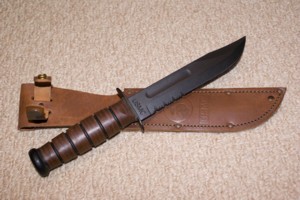
Error: Ka-Bar.
Error: Ka-Bar. Advantages: like all fixed blade knives, it's very solid. No fear of broken mechanisms or that the blade will fold back on our fingers. Disadvantages: like all fixed blade knives, it's very long, and since the blade doesn't fold into the handle, you need a separate sheath, which increases bulk. Conclusion: the more you live in the jungle, the more the disadvantages of this type of knife disappear, and the more it's advantages shine.
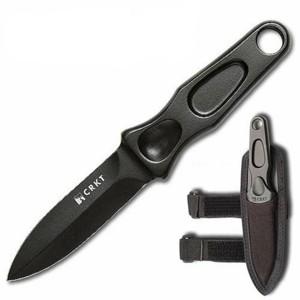
Error: CRKT Sting.
Error: CRKT Sting. Advantages: same as Ka-Bar. Being smaller, it should have been easier to carry, but the sheath is very big. Disadvantages: same as Ka-Bar, but add: very slippery metal handle, short blade, very heavy knife for it's small size.
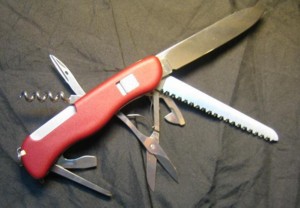
Error: Victorinox Outrider
Error: Victorinox Outrider. I wanted a more "tactical" jackknife, but that was still socially acceptable. Except the Outrider is visually bigger and more threatening than the Victorinox Climber, while still having the blade of a poodle. In other words, it barks louder, but doesn't bite much more, while taking up a lot of space and costing more.
Compactness. The Outrider is a lot less compact than the Climber. In the Climber, all the space is occupied, and visibly the tools were designed to fold back on each other to save space. I should have taken a picture of both jackknives one next to the other, seen from above: it's striking to see all the wasted space inside the Outrider. For example, the can opener and the flat screwdriver are exactly the same for both, but in the Climber their bevels are perfectly matched such as to allow them to overlap without touching when folded up. In the Outrider, they are just stupidly separated by an empty space. Another reason for the lower compactness of the Outrider is it's strangely-shaped handle.
The tools. The tools are mostly the same. Both jackknives are burdened with completely idiotic tools like the wine bottle opener, the toothpick, and the beer-bottle opener (for bottle caps that have practically disappeared from the market). The Outrider additionally has a wood saw (already a rarely-used tool), but with poor-quality teeth. (Why not a Japanese "Silky Gomboy" blade, and which cuts through wood like warm butter?) The Outrider also has a small Phillips screwdriver that is hard to deploy (you need to unfold the scissors first), apparently added just to cram something into the empty space in front of the scissors.
The main blade. It seems to me the Outrider is just a Climber stretched to make room for a bigger main blade. But this blade has several disadvantages. You can't open it with one hand, and it's kept open by the flimsiest mechanism I've ever seen in a folding knife. The blade is too thin to be solid. Moreover, it doesn't fold back completely into the handle (by several millimeters!), so it appears bigger than it is. Also, no belt clip, and the Outrider is heavy, so it bounces around all over the place when you go jogging. So you have all the disadvantages of a jackknife, and none of the advantages of a tactical folder.
To make a long story short, I was disappointed of the botched design job. I guess these days, even the Swiss engineers are made in China...
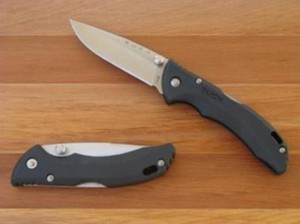
For camping: Buck Bantam.
More or less an error for camping: Buck Bantam. Advantages: folding blade, so no need for a separate sheath, and on top of that about half the length when folded. Belt clip makes it easy to attach to oneself, whatever we are wearing, and prevents the object from bouncing around when we run. The blade opens with one hand (ambidextrous). Very low price (it's one of the least expensive folding knives on the market). Very lightweight. Disadvantages: all those of a folding knife (see "Ka-Bar" here above), with additionally: rather uncomfortable handle, blade quickly dulls, and all the disadvantages of an inexpensive tool (lower quality), which in this case makes me even more paranoid about the blade locking mechanism.
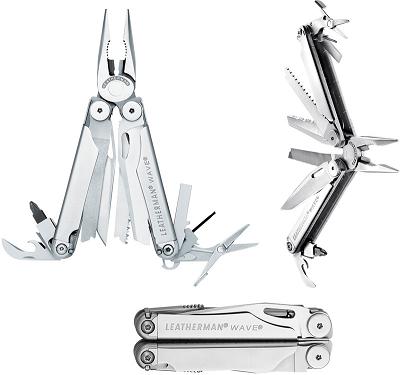
Not yet an error: Leatherman Multi-tool.
Not yet an error: Leatherman Multi-tool. So far, I have easily resisted the temptation of buying a multi-tool. It appears to me as having a fundamental design flaw: as soon as you have pliers, you separate your tool storage area in two (both handles of the pliers), so all your tools are automatically much smaller. Because of the size of the normal human body, and because of the size of the problems we are confronted with on a normal basis, there seems to be a minimal size required for most practical hand tools, and I claim that minimal size is broken by the multi-tool concept. Unless you are a professional miniature train repairman or something...
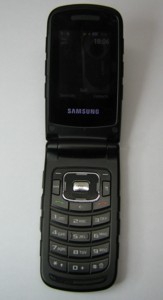
Description: A personal communication device using electromagnetic radiations. Normally a cellular telephone, but it could be a "walkie-talkie", etc.
Design: See Design Principle #2. In case of SHTF, often cellular telephone towers fail (call overload, backup batteries drain out after a few hours of generalized power shortage, towers voluntarily shut down by law enforcement, etc.). Moreover, a cell phone allows almost anybody to know where you are, what you are saying, what your list of contacts is, etc. Moreover, a cell phone can ring at the worst moment imaginable. In some SHTF situations, it's preferable to remove the battery, or to send the cellular telephone elsewhere so it will become a bait.
Includes: Only the cellular telephone as such is normally part of the EDC, but elsewhere we need a charger and spare batteries.
Use: Keep the battery charged. (I connect the charger every morning when I get up.) If it's a pre-paid, we have to regularly check to see if we have "any minutes left". (These days I check once a month over the Internet, and if I have less than 25$ on my account, I top it off.)
Vendor: Samsung Rugby II.
Price: 300$
Errors: These days, cellular telephones are becoming more and more personal computers, and less and less telephones. For now, I prefer the simplest communication devices possible, the most robust, with the least features possible. A "flip" or clamshell design prevents accidental keystrokes.
Moreover, phone companies love to chain us to long and costly contracts, while offering a swarm of "plans" that are hard to compare to each other (not like cheese, where the law requires the price per kilogram to be listed on the label; we can therefore compare several cheeses, even of different quantities and formats, and easily find the least expensive).
Error: The cellular telephone holder. After having seen so many people with special little pouches attached to their belts, to carry their cellular telephone, I succumbed to temptation and bought one. Gentle Jesus, what a stupid piece of junk! Very expensive, heavy and phenomenally large. And it closed with a magnet (therefore no guarantee that the phone will stay put even if you run in the undergrowth, or fall in the snow, etc.).

Description: Indelible ink replacment cartridge, nitrogen-pressurized (writes underwater, upside-down, in cold, etc.), with ultralight and compact pen body home-built with disposable Bic pen parts ("Hunter's Space Pen").
Design: You must have something to write with on yourself. A pen writes better and is more readable than a lead pencil. Good quality ink in pressurized cartrige is more reliable.
Price: 9$

Error: Fisher Matte Black Bullet Pen with clip
Errors: Fisher Matte Black Bullet Pen with clip: very expensive, and enormously heavy! Also, fussy to start writing with (cap must be removed), and the pocket clip tends to allow the pen to drop and get lost! Moreover, the slippery pen body let's it slide out of the hand. In general, all Fisher pens are big, heavy, and not ergonomic.
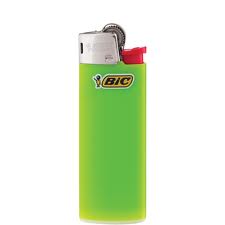
Description: Small butane disposable lighter.
Conception: Wood matches are bulkier, and more fragile. This lighter is only for emergencies (I never use it). The lighter in my toolbox is used regularly, so it's bigger and rechargeable.
Use: I wrap a bit of electrician's tape on the button to avoid gas leaks in my pocket. Stored in the wallet's little zippered compartment.
Vendor: Bic.
Price: 2$
Description: Very ordinary cotton hanky.
Use: I end up using it every day: to blow my nose (of course), to wipe my hands when I'm stuck somewhere like a public washroom without paper towels, to wrap my keychain so it won't rattle when I go jogging, as an improvised oven mitt to grab hot objects, as a rag to pick up spills, etc. When it's "discharged", I throw it in the laundry to "recharge" it!

Description: Ordinary belt, nylon strap with "Fastex"-type belt buckle.
Use: Plastic belt buckle breaks after a few years. Easy to replace.
Price: 10$
Description: Ordinary plastic bag with "ziploc" closure, large enough to contain the whole EDC.
Use: Kept folded in back pocket. Comes in handy when you get stuck in the rain. Also nice when we need to temporarily empty all of our pockets and we don't want to lose anything (like when passing security at the airport, etc.). I should run tests to see how long they remain waterproof (such bags wear out quickly because folded and sat on daily).

Description: The simplest and strongest waterproof digital watch you can find that still has a night light, an alarm-clock alarm feature, and replaceable wrist strap.
Design: Modern digital watches are a blessing! Robust, lightweight, inexpensive, with very readable numbers (even at night with the little light), user-friendly buttons, menus that aren't too complicated, a style that isn't too ugly (so I can wear it with shirt and tie), alarm-clock feature (and even sometimes several alarms, so I can sound the Angelus, etc.). Their rare shortcomings are to often be unecessarily complicated, and too thick.
Use: When the night light start to get dim, change the battery.
Price: 40$ approx.
Error: The non-replaceable wrist strap. My previous watch was almost perfect, except for non-replaceable synthetic wrist strap (no pins to hold a wristband; it's almost totally integrated into the watch body). This integrated wristband isn't sold separately, and you have to send the whole watch back to the company to have it changed. In itself, that wasn't so bad, but the plastic material starts to split and break after about a year. So you basically had to pay a whole new watch every few years, just by paying for those replacement wristbands... I had to search far and wide to find the same model but with a metal wristband, then throw away the wrist band (too heavy), spray paint the rest in black, and find a nylon wrist strap with velcro closure. And the cherry on the sundae is that models change so frequently, I'm not even sure I could buy the same thing anymore.
Error: Mechanical watch.

Error: TAG Heuer Aquaracer Calibre 5.
For some reason or another (fear of EMPs? fascination with tiny little mechanical devices that do fun things? fear of devaluation of fiat currency and desire to put money in tangible assets? well-made videos on servicing mechanical watches like those of Wristwatch Revival?), I lusted for a purely mechanical watch. It became one of the most expensive errors in my equipment (2400$ CAN around 2015).
In addition to the insane price, a purely mechanical watch has only shortcomings:
- Very sensitive to shocks. An electronic watch can fall to the ground, even several times, without consequences. The same fall for a mechanical watch will probably break the stem of the balance wheel, even if it's shock-mounted. And presto, broken watch, expensive repair.
- Stops keeping time very quickly. An electronic watch can last for years on the same small battery. Mechanical watches boast when they can run for more than 2 days without winding the spring. And if it stops, how can I get it back on track? We'd need a device that tells the time reliably, with which we could adjust the mechanical watch...
- Wears out like a pint of milk. If you store your electronic watch without its battery, it can hang around like that for decades. You put in a fresh battery, and presto! It works! But every mechanical watch has oil, and this oil oxidizes slowly. After a few years, you have to dismantle EVERYTHING, all the small mechanical parts inside, clean everything with solvent, re-oil everything carefully with special oils, and of course reassemble everything. In 2024, the price of typical maintenance is higher than the purchase price of a mid-range mechanical watch (not low-end, mid-range). A store owner who hires professional watchmakers to offer this type of service publicly wondered how manufacturers could offer this maintenance service at such a low price, unless they paid their professional watchmakers minimum wage. Do they hire homeless people to give them minimal training? Or more likely they throw the movement in the garbage and replace it with a new one, keeping the same case, dial and bracelet...
I even looked at prices to see how much it would cost me to do my own maintenance on my mechanical watch. A thousand US dollars in 2024, approximately, for the bare minimum (I include a timegrapher and a very low-end ultrasonic cleaner). And imagine the time and effort to learn how to use this equipment. And then I would need to find some place to store all this garbage!
- No integrated light. I often need to know what time it is, even though it's dark. For an electronic watch, it's child's play. For mechanical watches, heroic efforts are required (like small bottles of radioactive tritium on all the hands, and at each hour of the dial, and this tritium wears out after a few years).
- No alarms. I use the alarms on my electronic watch daily. One for my evening pill at 6 p.m., one to go to morning Mass at 7:20 a.m., etc. I've never heard of a mechanical watch with an alarm, let alone three alarms!
- Does not track months, years, time zones, etc. Each additional feature for a mechanical watch requires a "complication", a mechanism. Already displaying the date, like 2, 18, 27, is very difficult. Showing the day of the week as MON, THU, SUN is even more difficult. But changing the date and day correctly, month after month, year after year, forget it! The cheapest electronic watch does it without skipping a beat. And with other time zones, and a stopwatch, and a timer, and so on!
- Very heavy. I'm not talking about 20% heavier, I'm talking about two, three, four times heavier. It's a boat anchor on your wrist.
- Not very precise. Gaining or losing a few minutes per week is not uncommon for a mechanical watch. For an electronic watch, we are talking more about gaining or losing a few seconds per week.
- Very sensitive to position. Yes, a mechanical watch does not tick at the same speed depending on its orientation! What time is it? Um, it depends on how the watch was placed on your bedside table the day before!
- Perhaps sensitive to magnetism. A little flick of a magnet near certain mechanical watches, and presto, blocked and perhaps even broken.
- Doesn't tell the time! Har har! but seriously, is it 2 a.m., or 2 p.m.? After having an electronic watch all these years, I forget that a mechanical watch will show "2:00" hours in both cases, while an electronic watch will show 2:00, or 14:00!
- Often what is inside is quite ordinary. Most watch "manufacturers" do not make movements. They only provide what is visible to the suckers that buy them, such as the dial, the case, and lots of advertising. Then, the movement itself is supplied by one of the rare movement manufacturers, who supply anybody. Even among the few movement manufacturers, most copy old ETA models, which are no longer protected by patents. And of course the Chinese copy everybody! If automobiles were like mechanical watches, a Chrysler, a Ford, a Toyota, a BMW, a Mercedes, would all be the same thing under the exterior sheet metal!
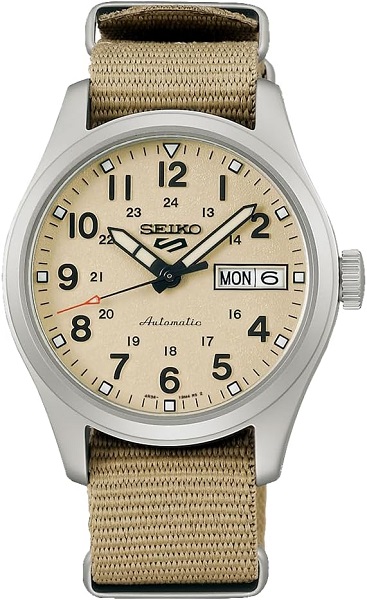
Error: SEIKO 5 Sport SRPJ83. Ten times less expensive
than my previous mistake, but still four times more expensive
than my current far superior watch!
For protection against EMPs, just throw a spare electronic watch into your anti-EMP box (which you have to have anyway for your spare computer), and presto, problem solved! For the fear of a forced devaluation of our currency, gold is a much better investment than a watch (retains its value better and is easier to resell).
Another way to see the overwhelming superiority of electronic watches is to look at the tool that all watchmakers use to maintain mechanical watches: a "timegrapher". It's an electronic gadget that costs about the price of a mid-range mechanical watch (like $200 USD in 2024), equipped with a small microphone. You place the mechanical watch on it, and the timegrapher will display on its screen the number of beats per second, the number of seconds that this watch will gain or lose each day, the amplitude of rotation (in degrees) of the balance wheel (another important indicator of the "health" of the mechanism), and also the variations duration of the period (the duration of one "tick" to another "tick").
Because of our constantly disintegrating bodies, some of us must carry additional items. If you are blind as a bat without your glasses, then they should be part of your EDC. If you have some medical condition that requires you to take pills or injections to stay alive, of course those need to be added, etc.
I currently prefer an EDC integrated into my pants, but many people prefer an EDC in a separate container. This separate container has itself many variations: material (solid, like a metal container, or some sort of synthetic fabric, etc.), size (from tiny container to very large), attachement to oneself (fanny-pack, bandolier, toolbelt, knapsack, etc.). And nothing prevents combinations, like a pair of pants that can tranform itself into a knap-sack (a bit like a currently available product at the MEC, a very lightweight knap-sack that can be compressed into it's own little pocket). Each variation of course has its own advantages and disadvantages.
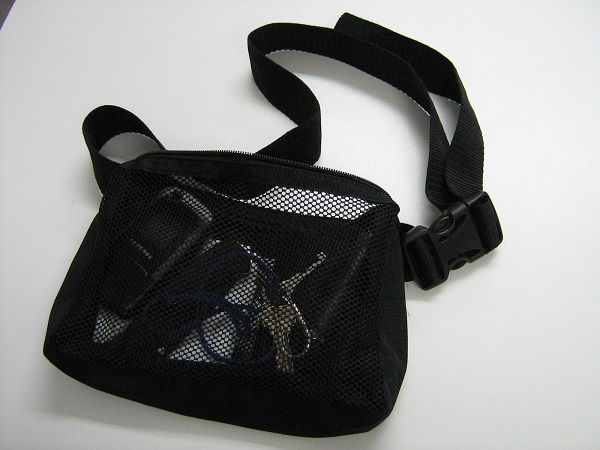
Home-rolled Adam's Belt.
(Small zipped pouch made of netting, about 15x22cm at the MEC,
sewn on 35mm black nylon strap belt)
Some general advantages of the separate container (i.e. of not integrating with pants):
- Easy to make the EDC tag along when you change clothes;
- Easy to protect against water (everything can be quickly put in a
waterproof bag);
- Fairly easy to find a socially-acceptable pouch (conversely, it's
hard to find cargo pants you can wear with a shirt and tie!);
Disadvantages:
- It's another thing you have to remember to carry along, whereas pants
tend to automatically follow us wherever we go (in my opinion, it's the
biggest advantage of an EDC integrated into pants, since I rarely leave
home without pants!);
- Slower speed of access to objects. A pair of pants with things in pockets
is the best-of-class storage method for speed and practicality (apart from
tool belts like those used by electricians, etc.).
- Cannot really be hidden underneath the pants (too bulky), whereas if
you distribute objects in pant pockets and clipped on the belt, you can
almost hide your EDC even if you're dressed in a formal shirt and tie;
- Maybe easier to have it stolen, because it's more visible, and cutting
a bag's strap and running away with it is probably easier than ripping off
someone's pants;
- Hard to resist the temptation of increasing the number and weight of
objects, and a fattened EDC ends up being left behind, so the day you really
need it, you don't have it.
Currently, I use the "EDC Pants" option, but I keep a small "Home-rolled Adam's Belt" which might come in handy some day.
A few more specific options with arguments for and against:
Cargo pant pockets transformable into a little pouch? After my battles with airport security to go to New-York in 2013, dressed in shirt and tie, I ardently desired a small pouch with shoulder strap or belt, with no metal components (to better pass security), with a zip, which would have contained my passport, boarding pass and EDC. Since the pants already have a belt and cargo pockets, could one of these pockets be reversible (like the little MEC knap-sack which can be packed into one of its pockets), and zipped shut? But the pants have to be made of fairly heavy fabric. The result would be quite large. Also, the zippered pocket of the carry-on knap-sack can play this role for such a rare scenario.
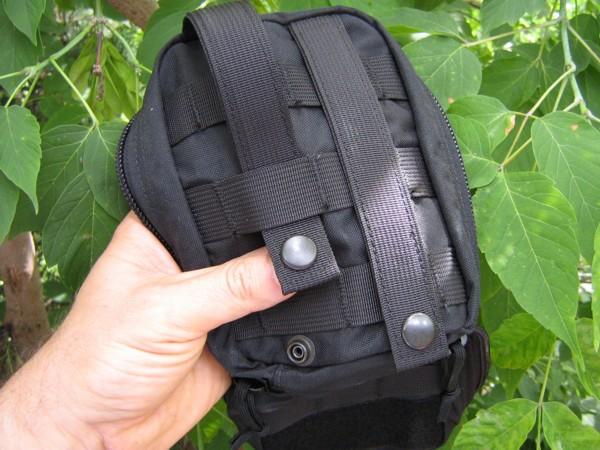
MOLLE pouch attachment mechanism.
MOLLE Pouch? I don't have much experience with MOLLE pouches. Yes, being able to connect them in many ways to many other MOLLE objects is nice. But I think this modularity is often excessive, and hence heavy and complicated. Only a few objects really need to have their own special pouches to be quickly accessible, like a soldier's ammunition pouches. For the rest, objects can usually just be stowed in the knapsack, which is far lighter. And all human-powered activities are very weight-sensitive.
A kind of toolbelt worn under clothing? Would have all the advantages of a separate container, while being very discreet, hard to steal, very "unbouncy" when running, etc. Except accessibility of object would be near zero... And if on top of clothing, bye-bye discretion and social acceptability...
Let's Adore Jesus-Eucharist! | Home >> Varia >> Bachelor's Kit